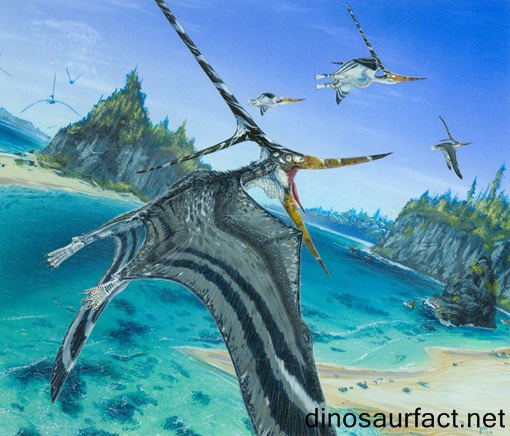 Click to visit the previous Pterosaurs bio
Click to visit the previous Pterosaurs bio
 |
|
 |
|
Kingdom: Animalia
Phylum: Chordata
Order: Pterosauria
Family: Nyctosauridae
Genus: Nyctosaurus
 |
|
 |
|
 |
|

The remains of an ancient genus of Pterosaur, the Nyctosaurus were found in the mid-western section of the US covered under the shallow water of the sea. The species that was found out was named Nyctosaurus for the gigantic cranial crest associated with that specific type of species. Nyctosaurus probably lived on the earth 65 million years ago.
The most amazing fact is that the Nyctosaurus was unfortunate to lose the clawed fingers. The species had specialty for having the wing finger though it was the phalanx that was not found. As a result of such handicap the bid failed to move on the land after its will. Probably it never felt ease to roam on the ground. Rather it found quite solace in hovering on the air spreading its giant wings. It was nothing but a conjecture so far. Probably owing to lack of claws the bird could not clasp the crags or cliffs of the hills or tree tops.
The name Nyctosaurus gracilis was given by Othniel Marsh in the year 1876. He found the fragments of the body in the Smoky Hill Riverside in the Kansas area of the US . Nyctosaurus actually means 'naked reptiles'. In the year 1881, Marsh was a bit confused and renamed the species Nyctodactylus. But in the year 1902, Samuel Wended Williston analyzed the remains of the species discovered in 1901 by H. Martin.
In 1953, Llewellyn found a part of the humerus in Brazil . It was estimated that the wingspan of the species discovered was four meters. But today there is a bit controversy regarding the form of the Nyctosaurus. Some scientists opine that the species belonged to a different genus.
In the year 1962, George Freyer Sternberg named a fragment N.bonneri and indicated it identical to the N.gracilis the wingspan of which was 290 centimeters. It was in 1978 when the complete skeleton of the species was recovered and it is accepted as the perfect specimen of the Nyctosaurus till date. In 1984 Robert Schoch renamed some fragments as Pteranodon nanus that means the 'the dwarf'. Christopher Bennett in the year 2003 suggested that the specimens that were found were none other than Nyctosaurus sp.
Most specimens he said were not of Nyctosaurus. Rather the smaller structures belonged to Pteranodon. He tried to tag it as the small individual of an unnamed species of the Nyctosaurus. A few modern scientists referred that the Pteranodon was a prototype of the giant antler. The crest proved to aid the species to hover in the air in an elegant style. Recently scientist Christopher Bennett remarked that the there was a possibility of the membrane attached to the crest. According to Bennett there was no evidence of attachment made of soft tissues. He came to the conclusion that the Nyctosaurus sp. had no soft tissue extensions were attached with edges that were extremely jagged.
In the year 2009, Scientist Xing and his colleagues found two species, one had a head sail and that another had no sail at all.Index
Extinct Profiles
 Triassic Dinosaurs
Triassic Dinosaurs Jurassic Dinosaurs
Jurassic Dinosaurs Cretaceous Dinosaurs
Cretaceous Dinosaurs Pterosaurs
Pterosaurs Marine Reptiles
Marine Reptiles Dinosaur Extinction
Dinosaur Extinction